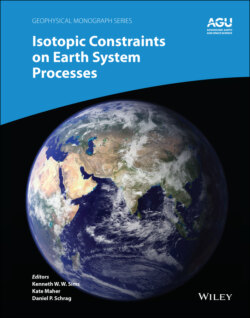Читать книгу Isotopic Constraints on Earth System Processes - Группа авторов - Страница 56
2.5.1. General Multicomponent Diffusion
ОглавлениеIn a multi‐component system, the diffusive flux Ji (moles m2/s) of component i is given by:
(2.3)
where Dik (m2/s) is the multicomponent diffusion matrix and Ck is the concentration of component k in volume‐normalized units. The off‐diagonal terms in the diffusion matrix represent diffusive coupling between components, which may be kinetic (the diffusing species have a stoichiometry that differs from the stoichiometry of the chosen components of the system) or thermodynamic (the flux of one component influences the activity or concentration of another). The full diffusion matrix has been determined for only a few simplified silicate liquid systems (Chakraborty et al., 1995; Kress & Ghiorso, 1993; Liang, 2010; Liang & Davis, 2002; Liang et al., 1996; Mungall et al., 1998; Oishi et al., 1982; Richter et al., 1998; Sugawara et al., 1977; Wakabayashi & Oishi, 1978; Watkins et al., 2014) as well as some basaltic liquids (Guo & Zhang, 2016, 2018; Kress & Ghiorso, 1995). The full diffusion matrix is not known for either phonolite or rhyolite. Even if it were known, it would be composition dependent in the mixing region between the two liquids, and at present there is no general way of dealing with such a complex diffusion problem. Therefore, it is not practical to use a multicomponent diffusion model for describing the fluxes in the rhyolite‐phonlite diffusion couple, and a simplified approach must be employed.
